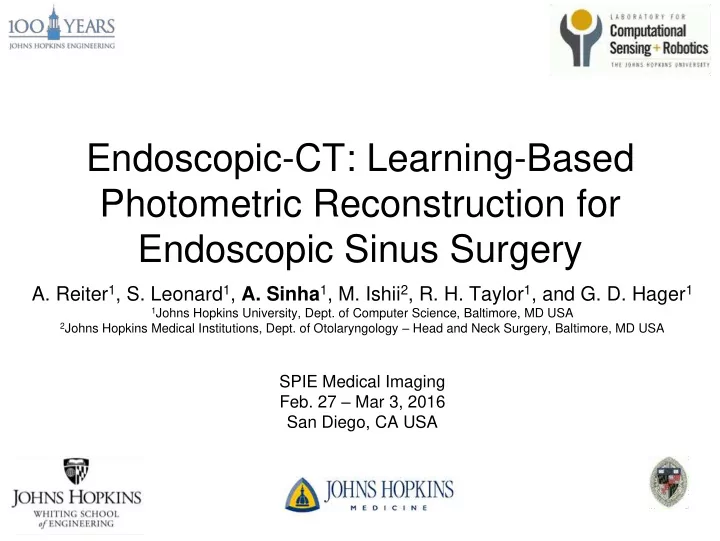

Endoscopic-CT: Learning-Based Photometric Reconstruction for Endoscopic Sinus Surgery A. Reiter 1 , S. Leonard 1 , A. Sinha 1 , M. Ishii 2 , R. H. Taylor 1 , and G. D. Hager 1 1 Johns Hopkins University, Dept. of Computer Science, Baltimore, MD USA 2 Johns Hopkins Medical Institutions, Dept. of Otolaryngology – Head and Neck Surgery, Baltimore, MD USA SPIE Medical Imaging Feb. 27 – Mar 3, 2016 San Diego, CA USA
Functional Endoscopic Sinus Surgery (FESS) • Sinus surgery typically performed under endoscopic guidance • Large percentage employ surgical navigation • Very critical and delicate anatomy requires high precision • We developed Video-CT registration that outperforms traditional navigation (~ 2mm ≤ 1.0mm) A comparison of our Video-CT registration (left) and traditional navigation using Optotrak* (right). The arrow indicates an obvious error in the latter. *http://www.ndigital.com/msci/product s/optotrak-certus/
Beyond Navigation • Reconstruction also important for in-situ FESS • Corresponding (surgically) disturbed anatomy to pre-op CT becomes challenging • Can perform intra-op CT, but risks exposing patient to additional radiation (e.g., situational awareness, metrology, etc) • This work presents Endoscopic-CT : video-based dense reconstruction using video to take place of intra-op CT Endoscopic Video Intra-operative CT 3D Anatomy
Paper Overview • Structure-from-Motion • Light and Surface Geometry • Training Process for Reconstruction • Results • Conclusions
Structure-from-Motion • Our methodology relies on gathering data from Structure-from-Motion (SfM) • Estimate 3- dimensional “structure” of a scene using a series of images Also recover camera geometry (positions and orientations) • • Relate 3D scene points to colored 2D pixels across several images (important for training later on!) Hierarchical Multi-Affine (HMA) Matching for 3D point cloud (green) generation + Trimmed- Low-Textured, Robust Feature Matching ICP yields Video-CT Registration SEE OUR VIDEO-CT PAPER HERE AT SPIE 2016!
Light and Surface Geometry • Due to low-texture, difficult to reconstruct densely (e.g., at all/most points) using traditional feature-based approaches • Instead exploit light reflectance properties • Bidirectional Reflectance Distribution Function (BRDF): relates incoming light, viewing direction, surface normal direction, and reflectance radiance If modeled accurately, fully describes scene geometry from pixel values • • Most use Lambertian Assumption (light reflected equally in all directions) Not really true for surgical data (e.g., tissue absorption, scattering, • liquids, etc)
Light and Surface Geometry The BRDF is a 4-dimensional function. Lambertian example: Encodes surface Surface property I R = r p L ( w i )cos( q i ) geometry Measured from r 2 image Scene Depth where: I R : reflectance ρ : diffuse albedo L( ω i ) : light source radiance onto surface at x θ i : angle between surface normal n(x) and light direction ω i r : distance between light source and surface point x
Training • We note that SfM yields a set of 3D points on the anatomy and associated colored 2D pixel locations from several images • Use this to train a general non-linear regressor to estimate the Inverse- BRDF . (Inverse lighting is an ill-formed problem; more unknowns than observations) We assume a fixed lighting direction (b/c camera fixed to imaging • source) We assume a fixed surface albedo (not completely correct, but • used as an approximation we will relax with future work) All scene geometry defined w.r.t. camera coordinates • • Therefore we reduce the problem to regressing the following function using SfM as training data (we get multiple views of the same 3D points, which gives a sense of differences in shading w.r.t to camera, since light follows camera!): f ( u , v , r , g , b ) = [ z , n x , n y , n z ]
Training f ( u , v , r , g , b ) = [ z , n x , n y , n z ] ( u , v ): pixel position ( r , g , b ): red-green-blue color at pixel position ( u , v ) z : depth of scene point corresponding to pixel position ( u , v ) ( n x , n y , n z ): unit surface normal vector corresponding to pixel position ( u , v ) Because f is unknown, we train a 3-layer neural network to regress from the training data.
System Overview
Experiments and Results • Training 103,665 SfM points from 36 images to train the regressor • Image resolution 1920x1080 • Train/Validate split: 77,748/25,917 (75%/25%) • Training validation error: 0.36mm in depth and 29.5° in surface normal • error • Testing : 6 independent test sequences (separate areas of sinus anatomy from • training, to demonstrate local robustness) With “clean” anatomy (less liquids), obtain average depth error as low as • 0.53mm. With more liquids present, depth error increases to as high as 1.12mm •
Experiments and Results 206 Total Images across 6 different “sequences” (each sequence focuses on a different non-overlapping part of the Sinus anatomy) For each sequence, total points reconstructed per-image , registered to CT through SfM+ICP for evaluation (average distance of predicted 3D point to closest triangle in CT mesh)
Experiments and Results Color Depth Photorealistic 3D
Conclusions • Presented method for estimating inverse lighting model per-patient (meant to be re-trained for each patient individually, on-the-fly) • Though constant albedo assumption is not correct, results show the variation in albedo is minimal across tissue • High accuracy 3D reconstruction that matches CT accurately. • Future Work: Relax albedo assumption • Improve surface normal accuracy • Learn a prior model from a collection of patients to improve per-patient • regression
THANK YOU! Questions/Comments? Work funded by NIH 5R01EB015530
Recommend
More recommend